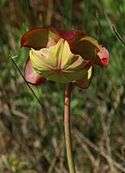Sarracenia purpurea
Sarracenia purpurea, commonly known as the purple pitcher plant, northern pitcher plant, turtle socks, or side-saddle flower, is a carnivorous plant in the family Sarraceniaceae.
| Purple pitcher plant | |
|---|---|
| Flowering Sarracenia purpurea, Coastal Maine Botanical Gardens | |
| Scientific classification | |
| Kingdom: | Plantae |
| Clade: | Tracheophytes |
| Clade: | Angiosperms |
| Clade: | Eudicots |
| Clade: | Asterids |
| Order: | Ericales |
| Family: | Sarraceniaceae |
| Genus: | Sarracenia |
| Species: | S. purpurea |
| Binomial name | |
| Sarracenia purpurea | |
 | |
| Sarracenia purpurea range | |

Distribution
Its range includes the Eastern seaboard and Gulf Coast of the United States, the Great Lakes region, all of Canada (except Nunavut and Yukon), Washington state, and Alaska.[1] That makes it the most common and broadly distributed pitcher plant, as well as the only member of the genus that inhabits cold temperate climates. The species is the floral emblem of the Canadian province of Newfoundland and Labrador. The species was introduced into bogs in parts of Ireland, where it has proliferated.[2]
It is an introduced and naturalized species in northern California. It is found in habitats of the native carnivorous species Darlingtonia californica, in the Klamath Mountains and northern Sierra Nevada.[3]
Description
Like other species of Sarracenia, S. purpurea obtains most of its nutrients through prey capture.[4] However, prey acquisition is said to be inefficient, with less than 1% of the visiting prey captured within the pitcher.[5] Even so, anecdotal evidence by growers often shows that pitchers quickly fill up with prey during the warm summer months. Prey fall into the pitcher and drown in the rainwater that collects in the base of each leaf.
Prey items such as flies, ants, spiders, and even moths, are then digested by an invertebrate community, made up mostly by the mosquito Wyeomyia smithii and the midge Metriocnemus knabi. The relationship between W. smithii and S. purpurea is an example of commensalism.[6]


Protists, rotifers (including Habrotrocha rosa), and bacteria form the base of inquiline food web that shreds and mineralizes available prey, making nutrients available to the plant.[7][8][9] New pitcher leaves do produce digestive enzymes such as hydrolases and proteases, but as the individual leaves get older into their second year, digestion of prey material is aided by the community of bacteria that live within the pitchers.[10][11]
Taxonomy
The species is further divided into two subspecies, S. purpurea subsp. purpurea and S. purpurea subsp. venosa. The former is found from New Jersey north, while the latter is found from New Jersey south and tolerates warmer temperatures.
In 1999, Sarracenia purpurea subsp. venosa var. burkii was described as a species of its own: Sarracenia rosea. This re-ranking has been debated among carnivorous plant enthusiasts since then, but further morphological evidence has supported the split.[12] The following species and infraspecific taxa are usually recognized:
- Sarracenia purpurea subsp. purpurea
- Sarracenia purpurea subsp. purpurea f. heterophylla
- Sarracenia purpurea subsp. purpurea f. ruplicola (invalid)
- Sarracenia purpurea subsp. venosa
- Sarracenia purpurea subsp. venosa var. burkii [=S. rosea]
- Sarracenia purpurea subsp. venosa var. burkii f. luteola[13]
- Sarracenia purpurea subsp. venosa var. montana
- Sarracenia purpurea subsp. venosa var. burkii [=S. rosea]
Uses
Sarracenia purpurea was used as a medicinal plant by Native American and First Nation tribes in its northeastern and Great Lakes distribution ranges, including the Algonquin, Cree, Iroquois, Mi'kmaq (Micmac) peoples,[14] primarily for use in treating smallpox by means of a root infusion.[15]
References
- USDA Distribution map of Sarracenia purpurea
- Foss, P.J. & O'Connell, C.A. (1985). "Notes on the ecology of Sarracenia purpurea L. on Irish peatlands". The Irish Naturalists' Journal. 21 (10): 440–443. JSTOR 25538921.
- Jepson Manual eFlora (TJM2) treatment of Sarracenia purpurea − naturalized distribution in California
- Wakefield AE; Gotelli NJ; Wittman SE; Ellison AM (2005). "Prey addition alters nutrient stoichiometry of the carnivorous plant Sarracenia purpurea". Ecology (abstract). 86 (7): 1737–1743. doi:10.1890/04-1673.
- Newell SJ; Nastase AJ (1998). "Efficiency of nutrient capture by Sarracenia purpurea (Sarraceniaceae), the Northern Pitcher Plant". American Journal of Botany. 85 (1): 88–91. doi:10.2307/2446558. JSTOR 2446558.
- C. Michael Hogan. 2011. Commensalism. Topic Ed. M.Mcginley. Ed-in-chief C.J.Cleveland. Encyclopedia of Earth. National Council for Science and the Environment. Washington DC
- Heard SB (1994). "Pitcher plant midges and mosquitoes: a processing chain commensalism". Ecology (abstract). 75 (6): 1647–1660. doi:10.2307/1939625. JSTOR 1939625.
- Mouquet N.; Daufresne T.; Gray S. M.; Miller T. E. (2008). "Modelling the relationship between a pitcher plant (Sarracenia purpurea) and its phytotelma community: mutualism or parasitism?". Functional Ecology. 22 (4): 728–737. doi:10.1111/j.1365-2435.2008.01421.x.
- Peterson C. N.; Day S.; Wolfe B. E.; Ellison A. M.; Kolter R.; Pringle A. (2008). "A keystone predator controls bacterial diversity in the pitcher-plant (Sarracenia purpurea) microecosystem". Environmental Microbiology. 10 (9): 2257–2266. doi:10.1111/j.1462-2920.2008.01648.x. PMID 18479443.
- Rice, Barry. (2007). About Sarracenia purpurea, the purple pitcher plant. The Carnivorous Plant FAQ. Accessed online: 21 June 2008.
- Gallie D. R.; Chang S.-C. (1997). "Signal transduction in the carnivorous plant Sarracenia purpurea. Regulation of secretory hydrolase expression during development and in response to resources". Plant Physiology. 115 (4): 1461–1471. doi:10.1104/pp.115.4.1461. PMC 158611. PMID 9414556.
- Ellison A. M.; Buckley H. L.; Miller T. E.; Gotelli N. J. (2004). "Morphological variation in Sarracenia purpurea (Sarraceniaceae): geographic, environmental, and taxonomic correlates" (PDF). American Journal of Botany. 91 (11): 1930–1935. doi:10.3732/ajb.91.11.1930. PMID 21652339.
- Hanrahan B.; Miller J. (1998). "History of Discovery: Yellow Flowered Sarracenia purpurea L. subsp. venosa (Raf.) Wherry var. burkii". Carnivorous Plant Newsletter. 27 (1): 14–17.
- Native American Ethnobotany DB: Sarracenia purpurea L. Documented uses.
- Charles Frederick Millspaugh (1892). American Medicinal Plants: An Illustrated and Descriptive Guide to Plants Indigenous to and Naturalized in the United States which are Used in Medicine (illustrated ed.). Courier Corporation. p. 76. ISBN 9780486230344.
External links
| Wikispecies has information related to Sarracenia purpurea |
| Wikimedia Commons has media related to: |


.jpg)
